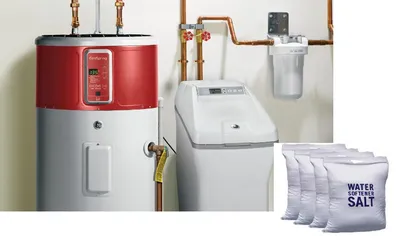HARD WATER TREATMENT – SALT VS NO SALT
How does a salt water softener work?
A water softener uses a medium that serves to exchange “ions” of calcium and magnesium with sodium and potassium. Traditional water softeners use salt as the medium, and salt-free water softeners from Magna-Tek do not.
This occurs in four steps:
- To do the ion replacement, the water in the house runs through a resin bed of small plastic beads or zeolite. The beads are covered with sodium or potassium ions. As the water flows past the ions, they swap places with the calcium and magnesium ions. Eventually, the beads contain nothing but calcium and magnesium, and softening stops. It is then time to regenerate the beads or zeolite.
- To regenerate, the beads need to regain their sodium or potassium ions by being flooded with a salty, brine solution that is rich in sodium or potassium.
- Once completed, the calcium and magnesium, dirt and sediments are flushed from the beads and into the drain in a process called backwash.
- The final phase rinses the mineral tank with fresh water and loads the brine tank so it’s ready for the next cycle.
Advantages of salt water softeners
- cleaner, softer feeling clothes
- longer life of appliances including washing machine, dishwasher, and water heater
- less use of household cleaning products, such as detergents, as well as personal cleanliness products, like shampoo
- reduction of water spotting
Disadvantages of Salt water Softeners
- softened water is not recommended for watering house plants, lawns and gardens due to its sodium content
- water used in recharging a water softener may over load or reduce the effectiveness of small septic or sewer systems
- there may be health risks from sodium intake
- softened water is not recommended for steam irons or evaporative coolers. The best choice for such appliances is distilled water or water from a reverse osmosis unit.
Health Risks Associated with Salt-Softened Water
During the softening process sodium is released from the exchange media into the output water. For every grain of hardness removed from water, 8 mg/1 (ppm) of sodium is added. People on restricted sodium intake diets should account for increased levels of sodium in softened water. Salt-free water softeners don’t have any of these risks or disadvantages.

Salt Water Softener
